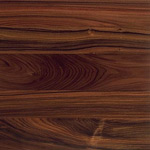Serving Upstate NY—VT—MA • For selections & prices, CALL or EMAIL US
Bolivian Rosewood (Morado)
Wood Flooring Species
Scientific Name:
Machaerium scleroxylon
Other Names and Species:
Caviuna
Jacaranda Pardo
Moradillo
Morado
Pau Ferro
Santos Palisander
Origin:
Bolivia and Brazil in South America, and also Central America.
Appearance:
Bolivian rosewood is not a true rosewood, but it is the next best thing. Most Rosewoods are endangered and not available for import. There are other species that are called “Bolivian rosewood,” but morado is rare in itself and not to be confused with imitators that are in no way similar.
The species is distinctive for its dark brown to violet color with black streaks or striping. Over time, the wood may lighten considerably from darker brown tones to lighter golden-tan colors. In addition, the broad color variation exhibited in freshly cut wood can undergo substantial muting over time. It has a uniform and moderately coarse texture.
Properties:
Bolivian rosewood is notably hard and dense, with a dimensional stability similar to that of red oak.
Janka Hardness: 1780
Bolivian rosewood is nearly ninety-seven percent as hard as pecan or hickory, roughly twenty-two percent harder than hard maple, about eight percent harder than wenge, almost exactly thirty-eight percent harder than red oak, and roughly eighty percent as hard as santos mahogany’s ranking of 2200.
Workability:
Despite its density, Bolivian rosewood works well and sands to a fine natural polish. Many oil-based finishes will not dry properly with this wood, so water-based stains are preferred.
Principal Uses:
Bolivian rosewood is generally useful for the same purposes as the Brazilian variety, including decorative veneers, fine furniture, cabinet work, and specialty items.
Learn more about available grades of
Bolivian Rosewood hardwood flooring »





